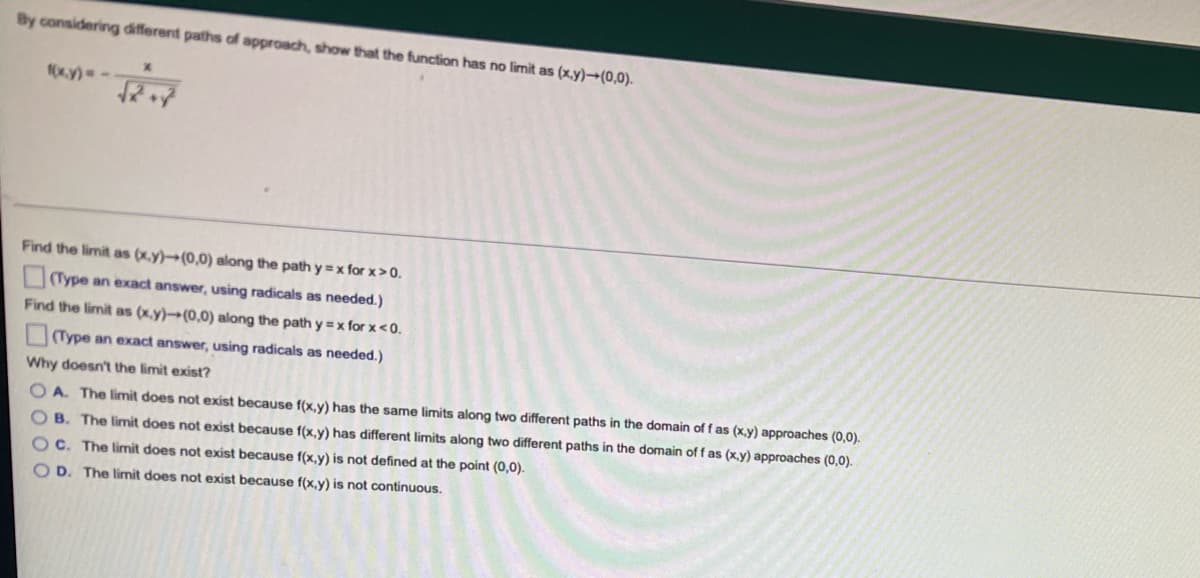ering different paths of approach, show that the function has no limit as (x,y)-(0,0). f(x,y)=- Find the limit as (x,y)-(0,0) along the path y=x for x > 0. (Type an exact answer, using radicals as needed.) Find the limit as (x,y)-(0,0) along the path y = x for x <0. (Type an exact answer, using radicals as needed.) Why doesn't the limit exist? OA. The limit does not exist because f(x,y) has the same limits along two different paths in the domain of f as (x,y) approaches (0,0). OB. The limit does not exist because f(x,y) has different limits along two different paths in the domain of f as (x,y) approaches (0,0). OC. The limit does not exist because f(x,y) is not defined at the point (0,0). OD. The limit does not exist because f(x,y) is not continuous.
ering different paths of approach, show that the function has no limit as (x,y)-(0,0). f(x,y)=- Find the limit as (x,y)-(0,0) along the path y=x for x > 0. (Type an exact answer, using radicals as needed.) Find the limit as (x,y)-(0,0) along the path y = x for x <0. (Type an exact answer, using radicals as needed.) Why doesn't the limit exist? OA. The limit does not exist because f(x,y) has the same limits along two different paths in the domain of f as (x,y) approaches (0,0). OB. The limit does not exist because f(x,y) has different limits along two different paths in the domain of f as (x,y) approaches (0,0). OC. The limit does not exist because f(x,y) is not defined at the point (0,0). OD. The limit does not exist because f(x,y) is not continuous.
Chapter3: Functions
Section3.3: Rates Of Change And Behavior Of Graphs
Problem 2SE: If a functionfis increasing on (a,b) and decreasing on (b,c) , then what can be said about the local...
Related questions
Question

Transcribed Image Text:By considering different paths of approach, show that the function has no limit as (x,y)-(0,0).
f(x,y)=-- √2+
Find the limit as (x,y)-(0,0) along the path y=x for x > 0.
(Type an exact answer, using radicals as needed.)
Find the limit as (x,y)-(0,0) along the path y = x for x <0.
(Type an exact answer, using radicals as needed.)
Why doesn't the limit exist?
OA. The limit does not exist because f(x,y) has the same limits along two different paths in the domain of f as (x,y) approaches (0,0).
OB. The limit does not exist because f(x,y) has different limits along two different paths in the domain of f as (x,y) approaches (0,0).
OC. The limit does not exist because f(x,y) is not defined at the point (0,0).
D. The limit does not exist because f(x,y) is not continuous.
Expert Solution
This question has been solved!
Explore an expertly crafted, step-by-step solution for a thorough understanding of key concepts.
Step by step
Solved in 2 steps with 1 images

Recommended textbooks for you

